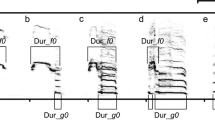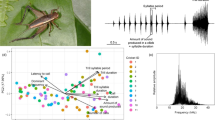Abstract
We investigated how male age and body weight influence male mating effort in the bell cricket Meloimorpha japonica. We adopted a longitudinal approach to study resource allocation to male mating effort (calling duration during 24 h) in the bell cricket. Calling durations and body weight of each male were measured at 7–8 days (young age), 14–15 days (middle age), and 22–25 days (old age) after the final molt. Calling duration increased between young and middle age. During the period between middle and old age, the amount of change in the calling duration was positively correlated with the body weight. The results suggested that older (i.e., low residual reproductive value) and better quality males invested more resources in mating effort.




Similar content being viewed by others
References
Badyaev AV, Qvarnström A (2002) Putting sexual traits into the context of an organism: a life-history perspective in studies of sexual selection. Auk 119:301–310
Brooks R, Kemp DJ (2001) Can older males deliver the good genes? Trends Ecol Evol 16:308–313
Forstmeier W (2002) Comparing cross-sectional with longitudinal analyses. Anim Behav 64:F9–F11
Forstmeier W, Hasselquist D, Bensch S, Leisler B (2006) Does song reflect age and viability? A comparison between two populations of the great reed warbler Acrocephalus arundinaceus. Behav Ecol Sociobiol 59:634–643
Gil D, James LS, Slater PJB (2001) Song characteristics are age dependent in the willow warbler, Phylloscopus trochilus. Anim Behav 62:689–694
Gray DA (1999) Intrinsic factors affecting female choice in house crickets: time cost, female age, nutritional condition, body size, and size-relative reproductive investment. J Insect Behav 12:691–700
Gray DE, Eckhardt G (2001) Is cricket courtship song condition dependent? Anim Behav 62:871–877
Gwynne DT (2008) Sexual conflict over nuptial gift in insects. Annu Rev Entomol 53:83–101
Hack MA (1997) Assessment strategies in the contests of male crickets Acheta domesticus (L.). Anim Behav 53:733–747
Harrison RG (1980) Dispersal polymorphisms in insects. Annu Rev Ecol Syst 11:95–118
Höglund J, Sheldon BC (1998) The cost of reproduction and sexual selection. Oikos 83:478–483
Hollander M, Wolfe DA (1999) Nonparametric statistical methods. Wiley, New York
Holm S (1979) A simple sequentially rejective multiple test procedure. Scand J Stat 6:65–70
Hunt J, Brooks R, Jennions MD, Smith MJ, Bentsen CL, Bussière LF (2004a) High-quality male field crickets invest heavily in sexual display but die young. Nature 432:1024–1027
Hunt J, Bussière LF, Jennions MD, Brooks R (2004b) What is genetic quality? Trends Ecol Evol 19:329–333
Hunt J, Jennions MD, Spyrou N, Brooks R (2006) Artificial selection on male longevity influences age-dependent reproductive effort in the black field cricket Teleogryllus commodus. Am Nat 168:E72–E86
Iwasa Y, Pomiankowski A, Nee S (1991) The evolution of costly mate preferences II. The “handicap” principle. Evolution 45:1431–1442
Jacot A, Scheuber H, Brinkhof MWG (2007) The effect of age on a sexually selected acoustic display. Ethology 113:615–620
Judge KA, Ting JJ, Gwynne DT (2008) Condition dependence of male life span and calling effort in a field cricket. Evolution 62:868–878
Kodric-Brown A, Nicoletto PF (2001) Age and experience affect female choice in the guppy. Am Nat 157:316–323
Kokko H (1997) Evolutionary stable strategies of age-dependent sexual advertisement. Behav Ecol Sociobiol 41:99–107
Kokko H, Brooks R, Jennions MD, Morley J (2003) The evolution of mate choice and mating biases. Proc R Soc Lond B 270:653–664
Korn EL (1984) Kendall’s tau with a blocking variable. Biometrics 40:209–214
Kuriwada T, Kasuya E (2006) Female responsiveness is negatively correlated with life expectancy in Meloimorpha japonica (Orthoptera: Gryllidae). Ann Entomol Soc Am 99:1244–1247
Kuriwada T, Kasuya E (2009) Longer copulation duration increases the risk of injury during copulation in the male bell cricket Meloimorpha japonica. Entomol Sci 12:141–146
Martin P, Bateson P (1986) Measuring behaviour. Cambridge University Press, Cambridge
Mauck RA, Huntington CE, Grubb TC Jr (2004) Age-specific reproductive success: evidence for the selection hypothesis. Evolution 58:880–885
Miller LK, Brooks R (2005) The effects of genotype, age, and social environment on male ornamentation, mating behavior, and attractiveness. Evolution 59:2414–2425
Mole S, Zera AJ (1993) Differential allocation of resources underlies the dispersal-reproduction trade-off in the wing-dimorphic cricket, Gryllus rubens. Oecologia 93:121–127
Moore PJ, Moore AJ (2001) Reproductive aging and mating: the ticking of the biological clock in female cockroaches. Proc Natl Acad Sci USA 98:9171–9176
Proulx SR, Day T, Rowe L (2002) Older males signal more reliably. Proc R Soc Lond B 269:2291–2299
Ritchie MG, Couzin ID, Snedden WA (1995) What’s in a song? Female bush crickets discriminate against the song of older males. Proc R Soc Lond B 262:21–27
Roff DA (2002) Life history evolution. Sinauer, Sunderland
Savage IR (1956) Contributions to the theory of rank order statistics—the two sample case. Ann Math Stat 27:590–615
Simmons LW (1986) Inter-male competition and mating success in the field cricket, Gryllus bimaculatus (De Geer). Anim Behav 34:567–579
Stearns SC (1992) The evolution of life histories. Oxford University Press, New York
Wedell N, Ritchie MG (2004) Male age, mating status and nuptial gift quality in a bushcricket. Anim Behav 67:1059–1065
Zahavi A (1975) Mate selection—a selection for a handicap. J Theor Biol 53:205–214
Acknowledgments
We thank our colleagues in the laboratory of ecological science at Kyusyu University for their support and stimulating discussions. We are indebted to T. Masuda for providing the crickets and rearing information. This study was supported in part by the Sasakawa Scientific Research Grant from the Japan Science Society and Fujiwara Natural History Foundation to T.K. and the Grant-in-Aid in Scientific Research from the Japan Society for the Promotion of Science (nos. 16370013 and 16370045) to E.K. The manuscript was greatly improved by the valuable comments of two anonymous reviewers.
Author information
Authors and Affiliations
Corresponding author
About this article
Cite this article
Kuriwada, T., Kasuya, E. Age-dependent changes in calling effort in the bell cricket Meloimorpha japonica . J Ethol 29, 99–105 (2011). https://doi.org/10.1007/s10164-010-0231-3
Received:
Accepted:
Published:
Issue Date:
DOI: https://doi.org/10.1007/s10164-010-0231-3




